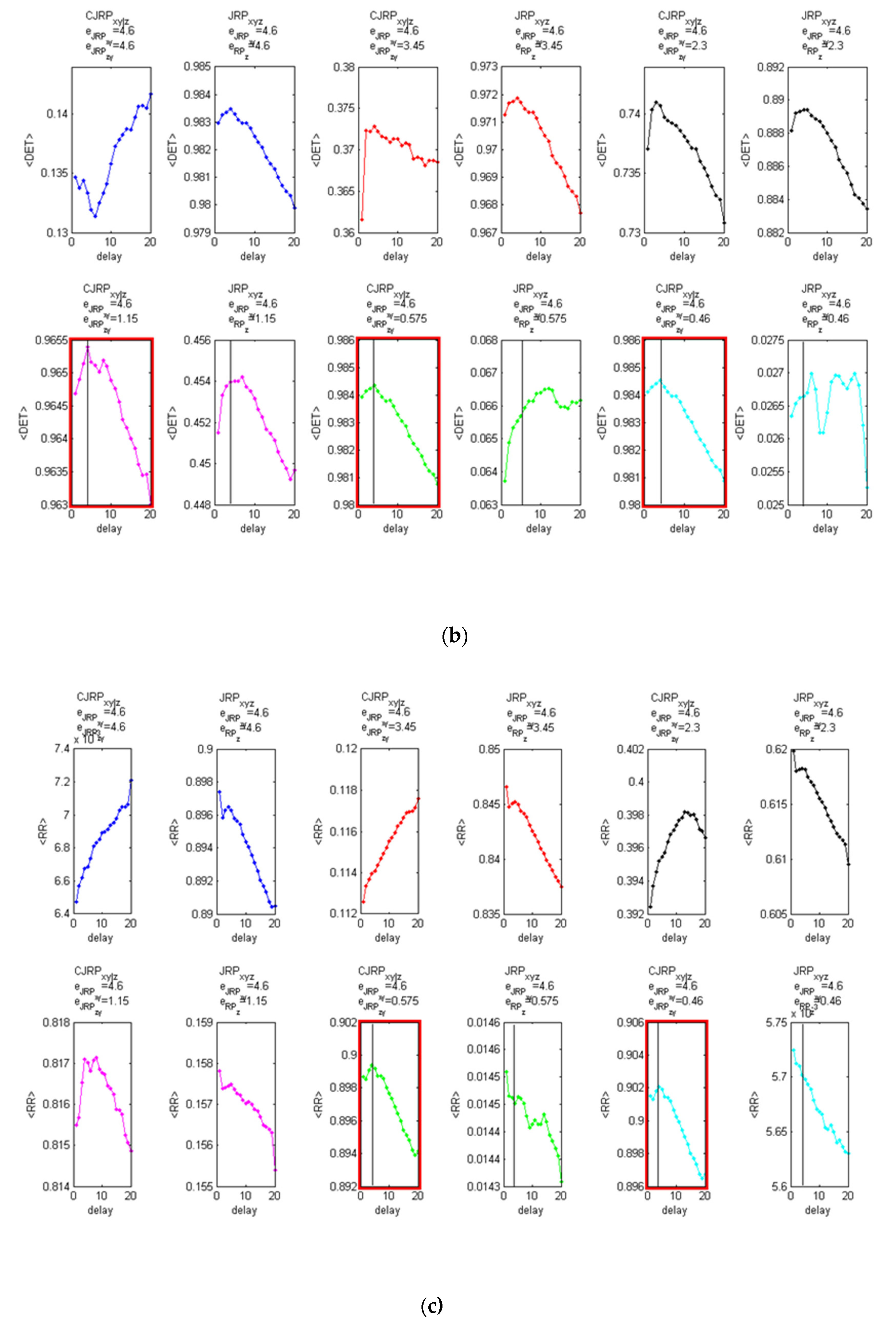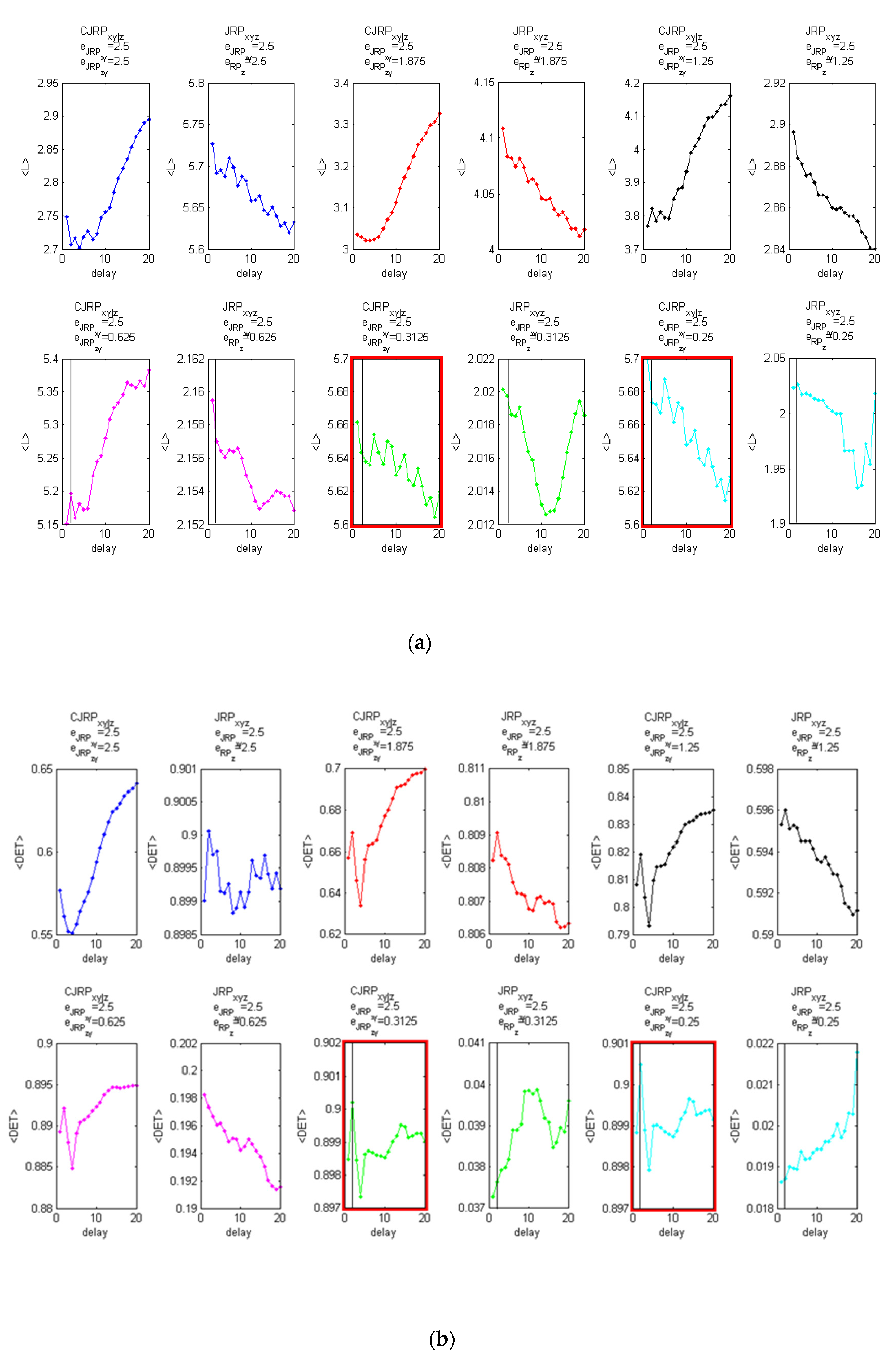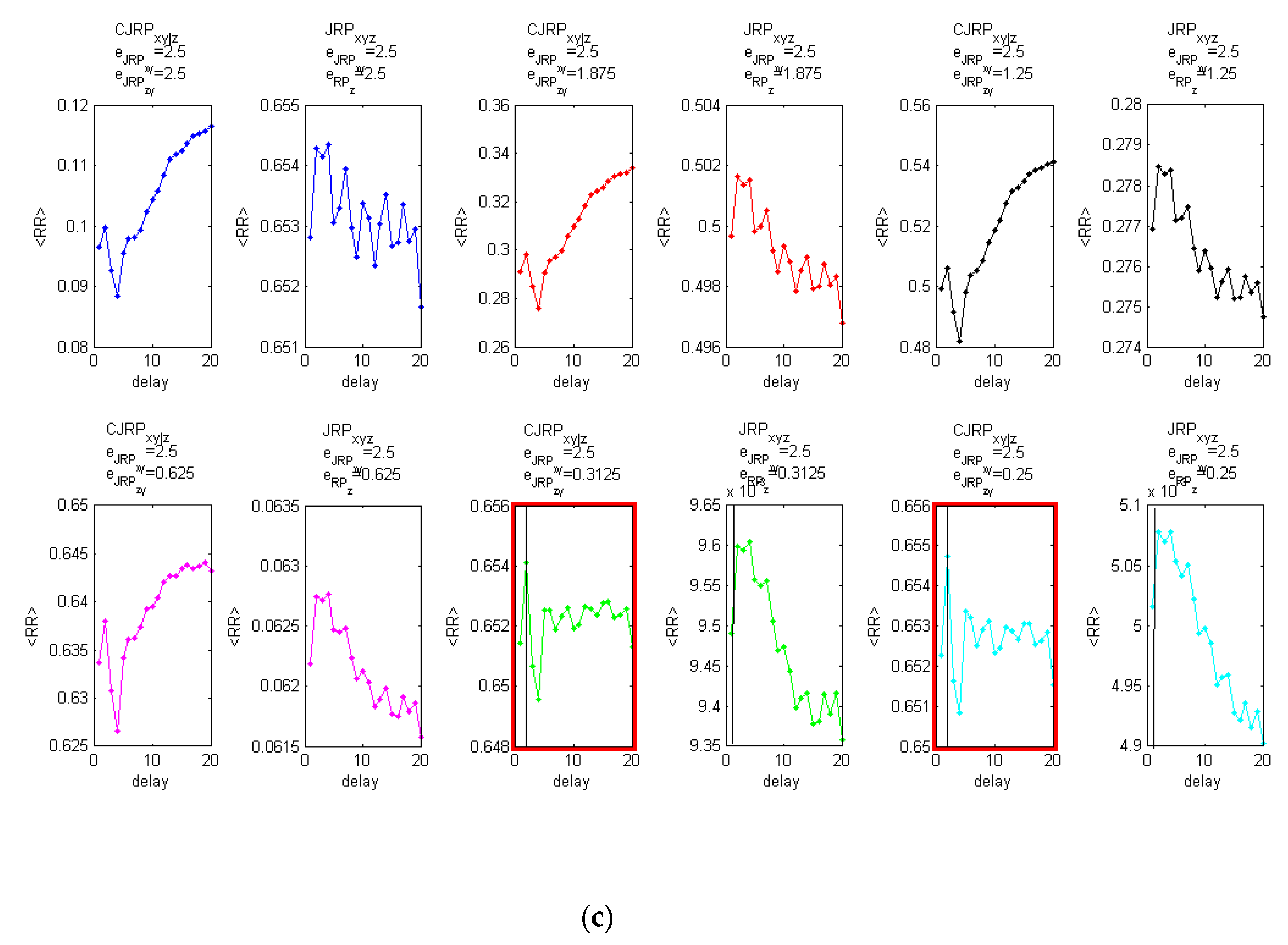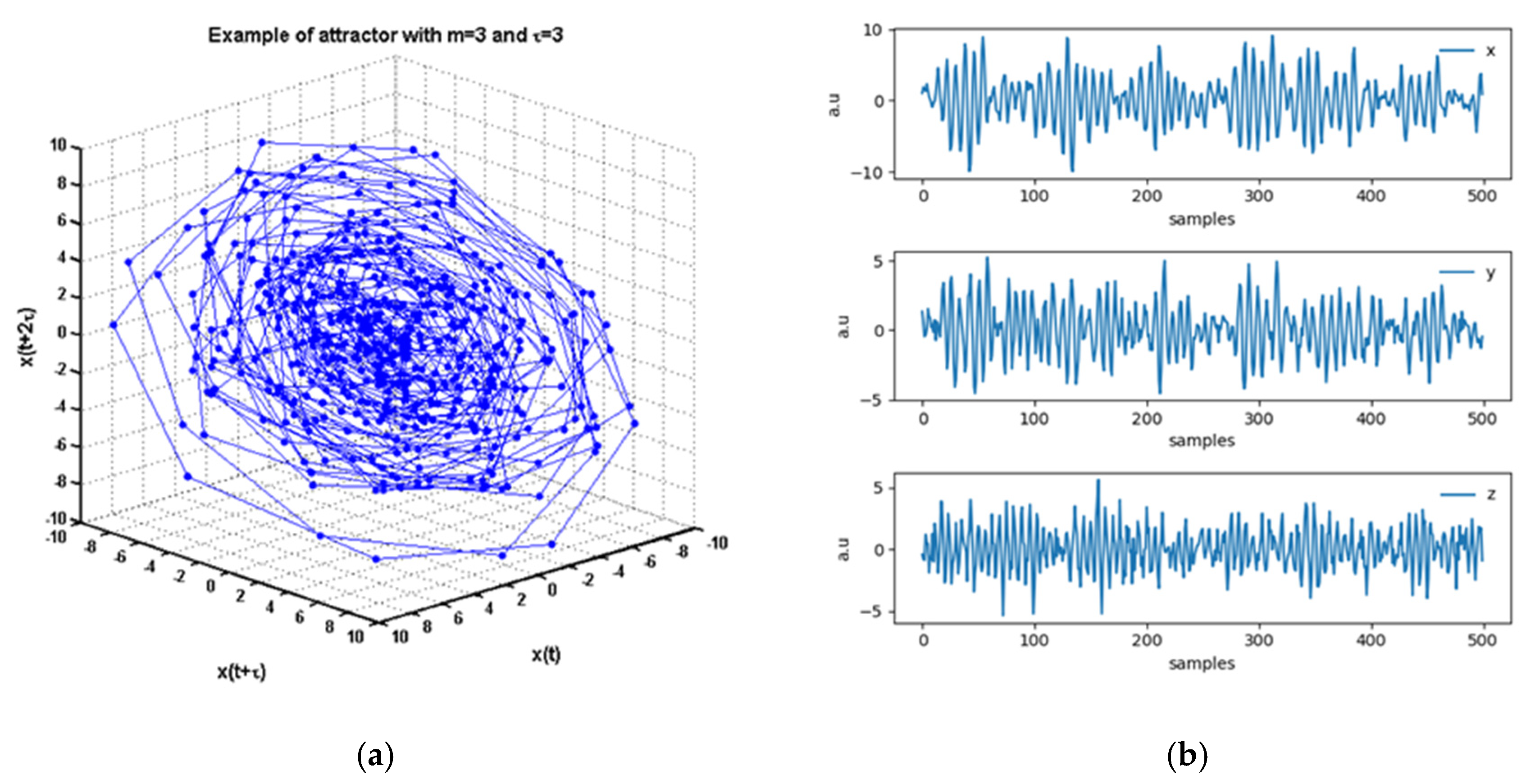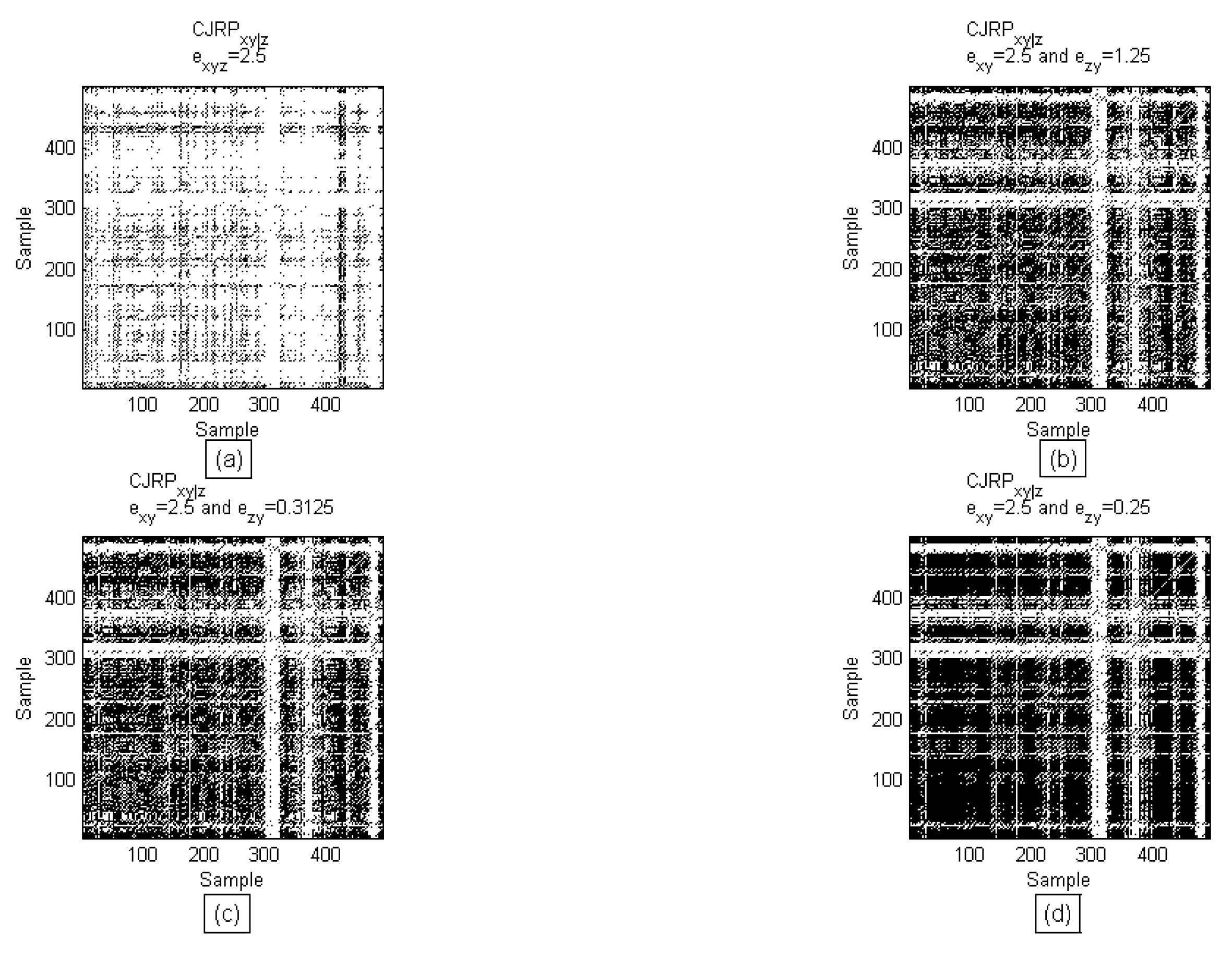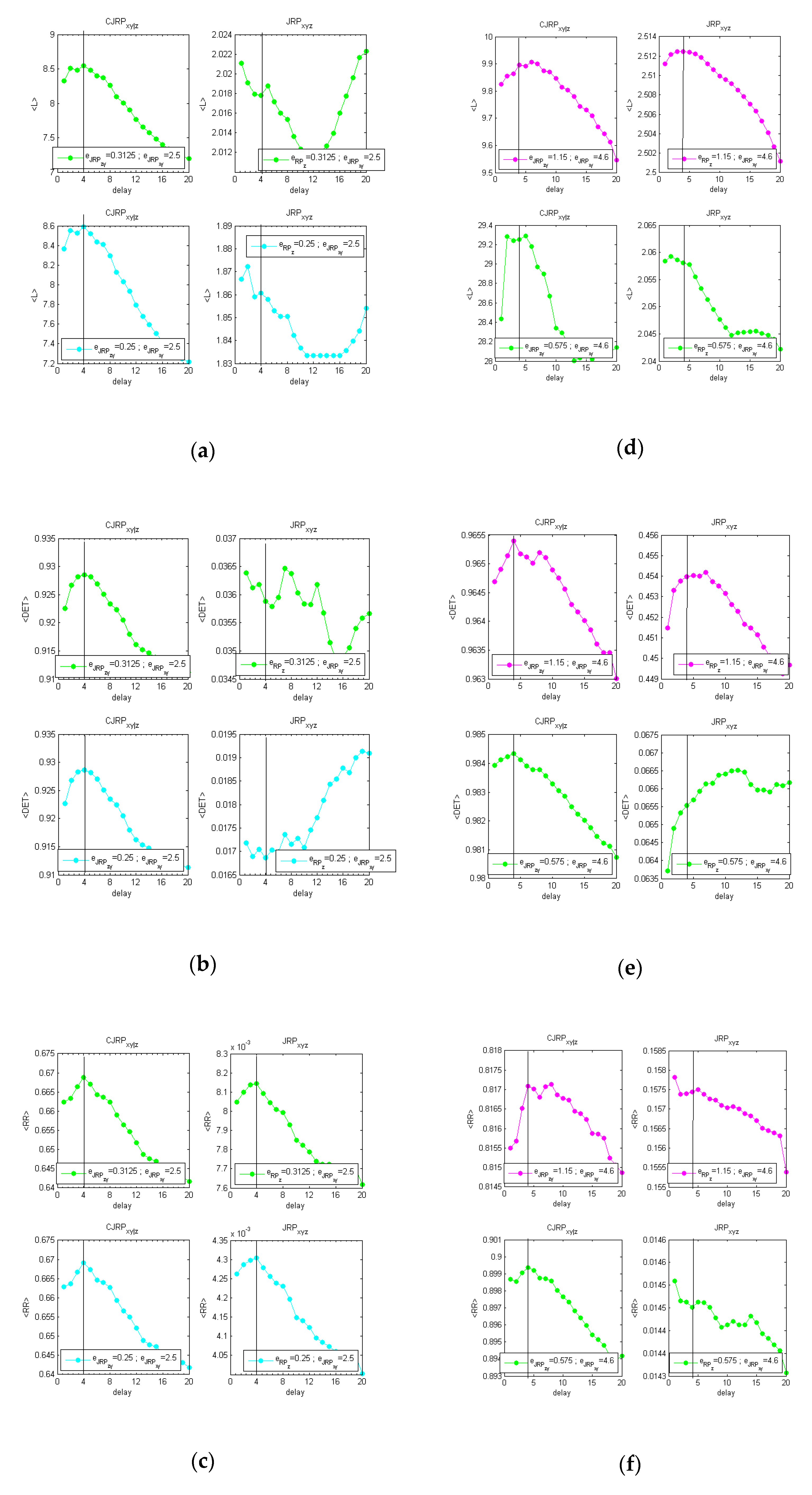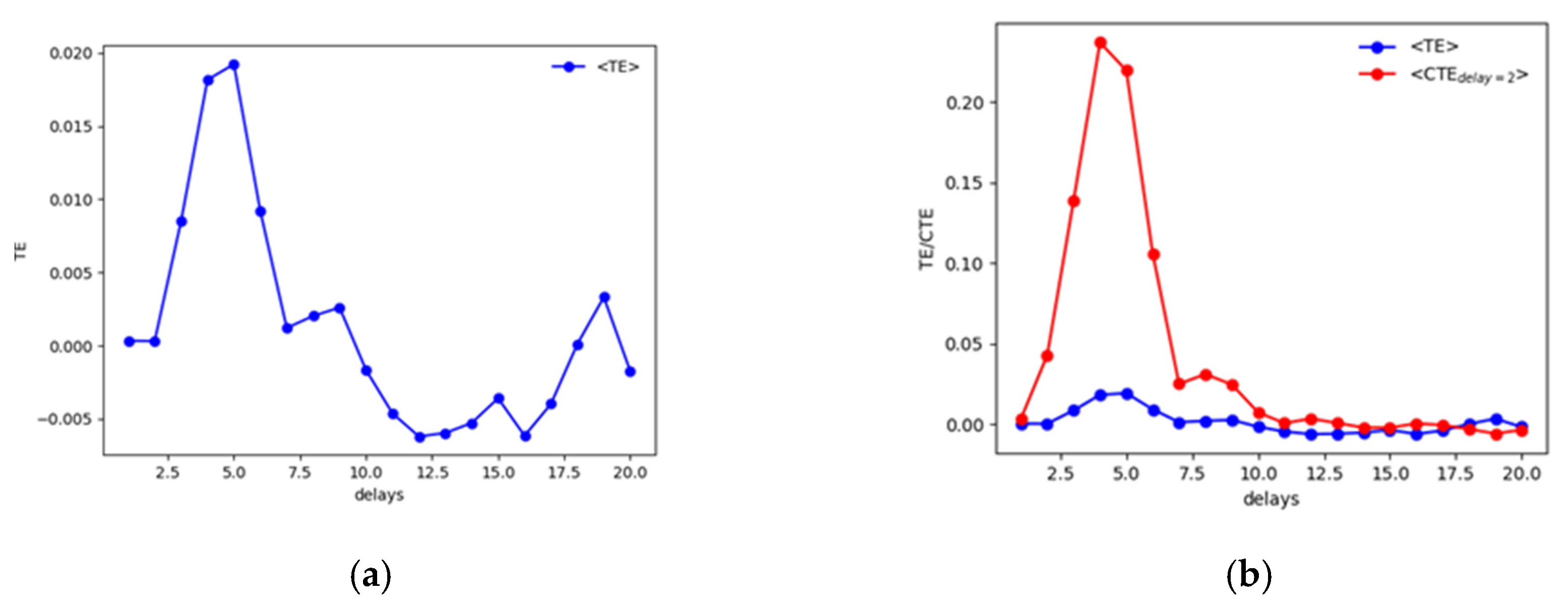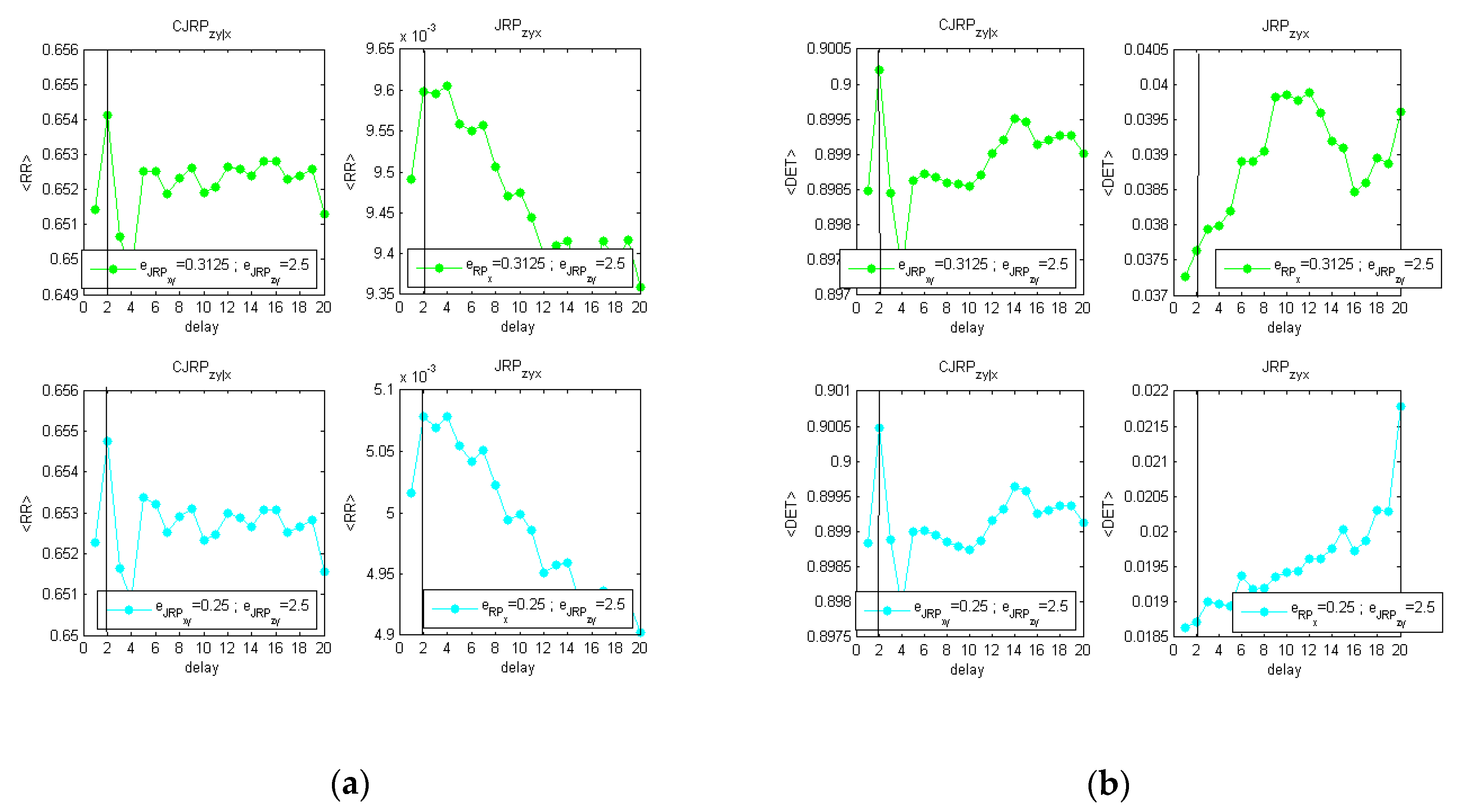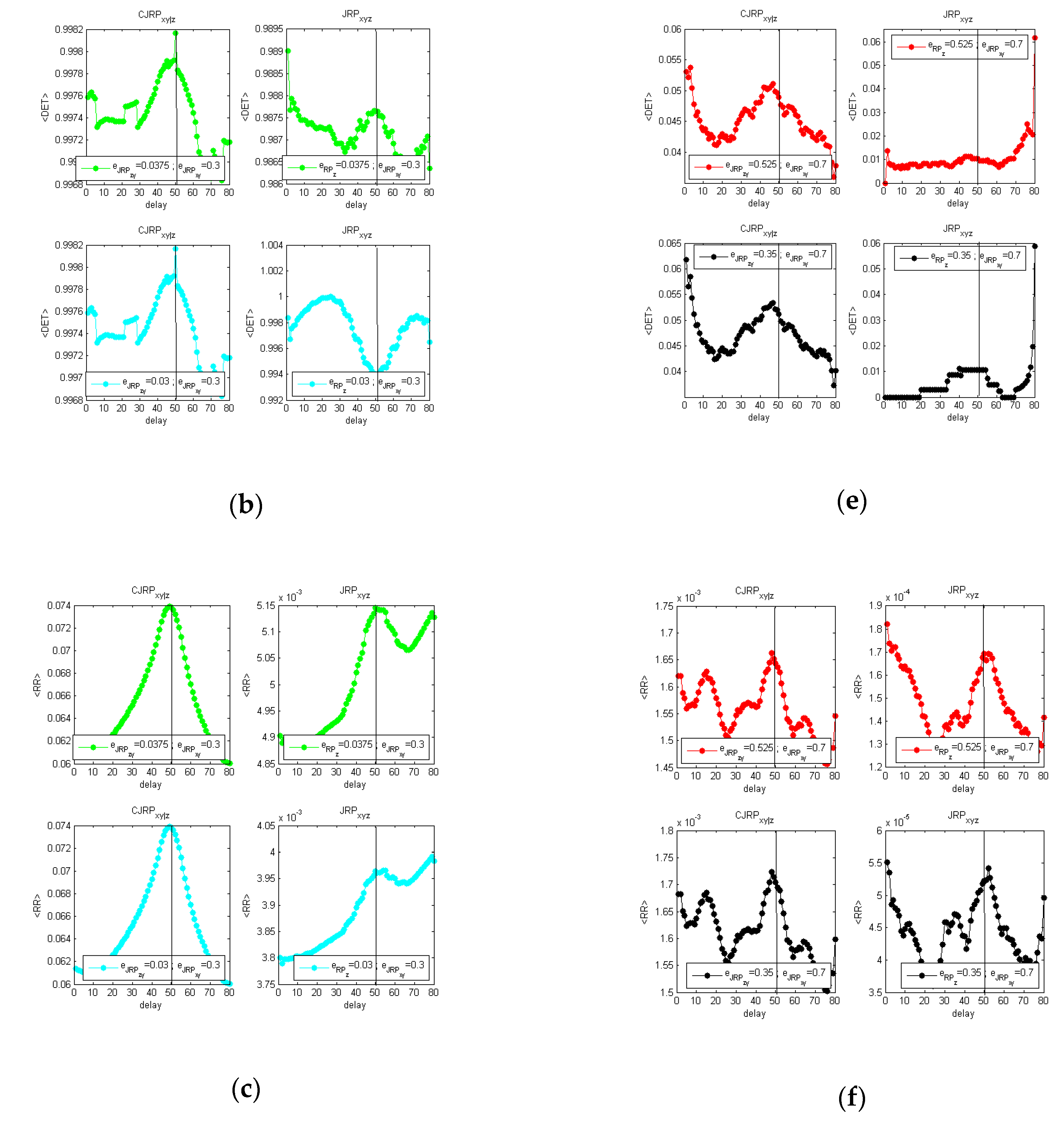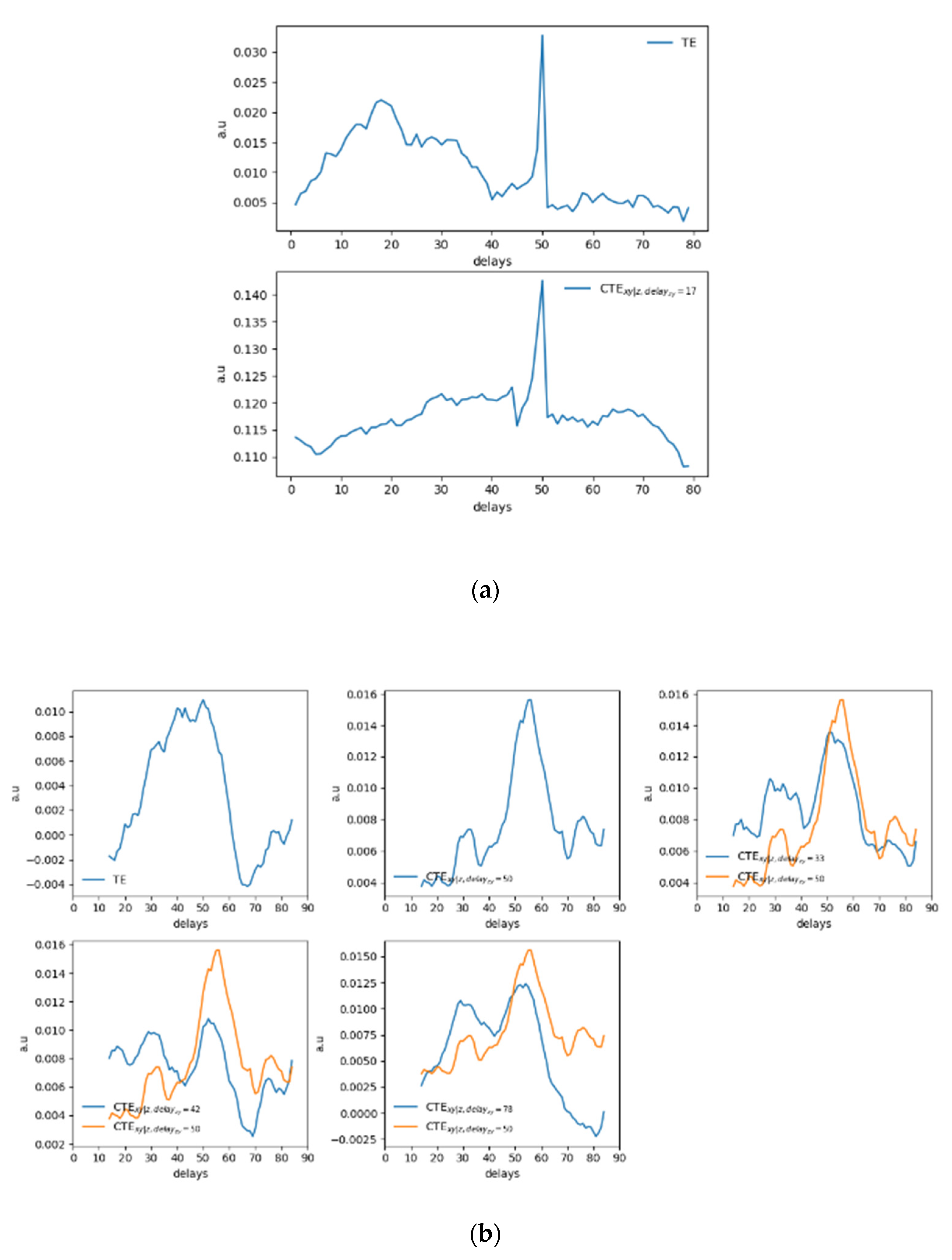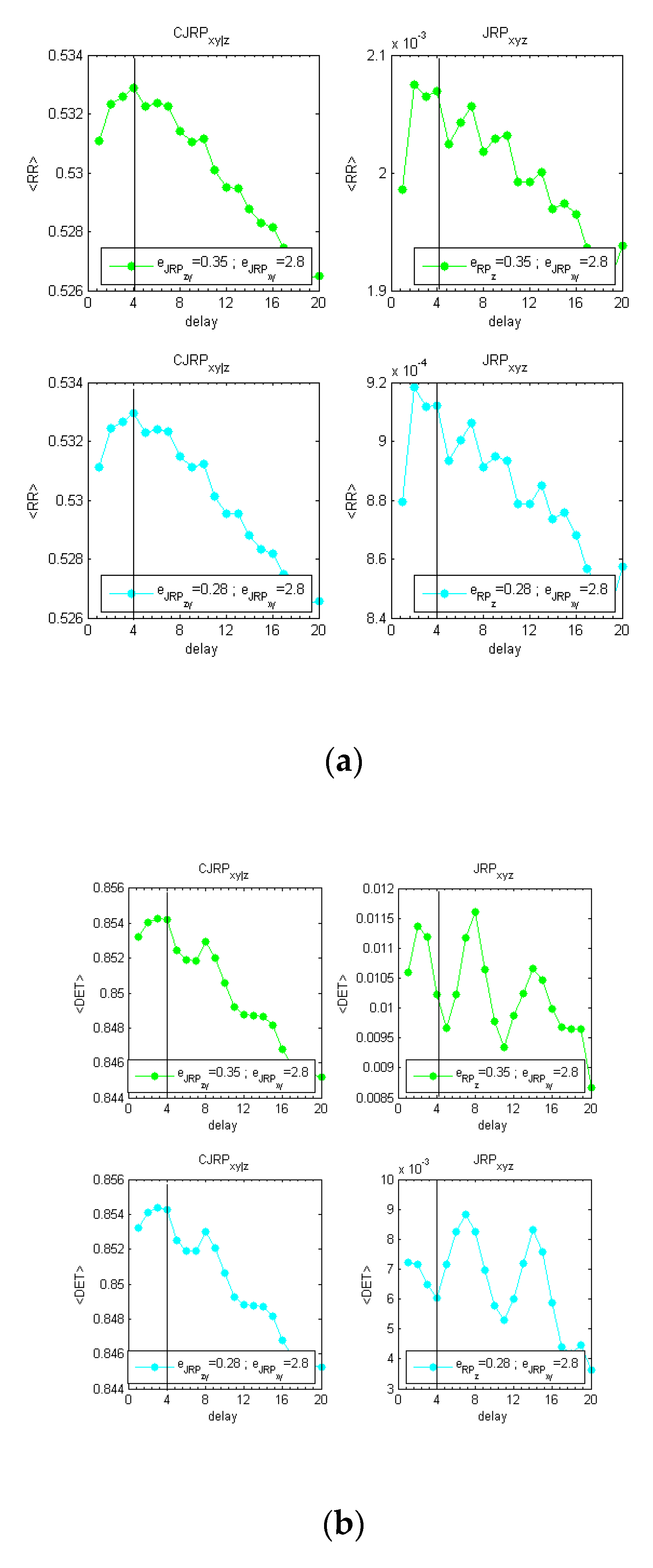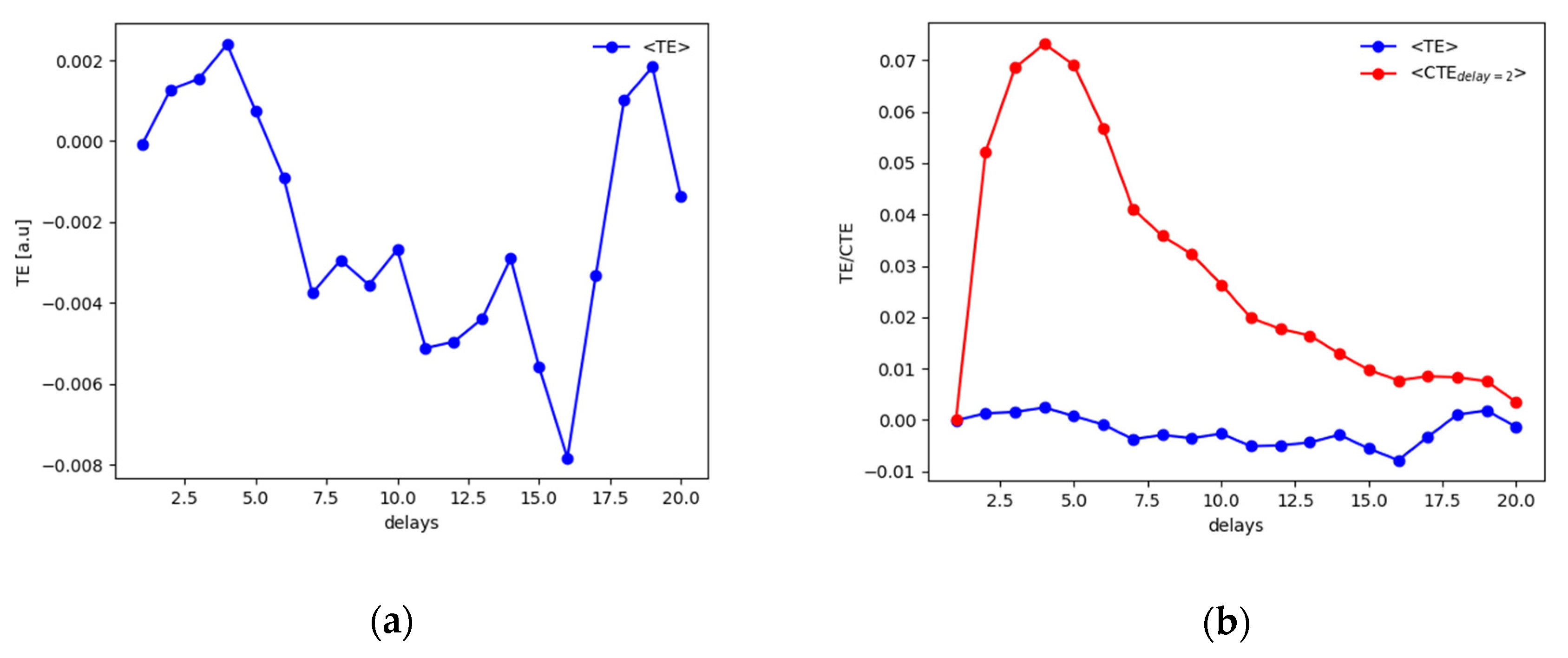1. Multiple Causality between Time Series
Most specialists agree to trace the concept of synchronization back to Huygens and his study on what we define today as antiphase synchronized pendula. Presently, the study of synchronization between dynamical systems is generally focused on determining the nature of the coupling among the observables involved. As different forms of mutual influence exist, different synchronization typologies can be defined as well. Phase synchronization, generalized synchronization, and lag synchronization are just some examples [
1]. Several valuable theoretical approaches have been proposed, see, e.g., in [
2,
3,
4], for their assessment. In practical applications, the evolution of the generalized and phase synchronizations between two quantities are among the most widely studied, while lag synchronization is often aimed at inferring the delay of the maximal influence between two observables.
As dynamical systems can be observed in all of natural science, from medicine and biology to engineering and physics, the interest on their coupling, dynamic, and relation is a still very active topic of research. In biology, for example, Pavlova et al. [
5] applied the detrended fluctuation analysis (DFA) to characterize complex interactions between neurophysiological signals, to avoid destroying the long-range correlation in the original data using prefiltering techniques. In medicine, studies about brain signals have motivated the development of different new approaches such as the use of the complex networks to understand the relationship between brain organization and behavior [
6]. Considering climate application also, a new method, called the Reservoir Computing Causality method (RCC), has been recently developed by Huang et al. [
7], and also compared with the Extended Convergent Cross Mapping (ECCM) [
8] to identify the causal direction, coupling delay between two quantities described by two time series. This method has the advantage of not requiring the estimation of the embedding dimension and of the delay time. In engineering, Tirabassi et al. studied the relation between inferred functional networks and the underlying structural networks between two dynamical systems, a simulated set of Kuramoto oscillators, and an experimental set of Rössler chaotic electronic circuits, finding that there were regimes of the dynamics in which the functional connectivity of the system mimics the structural one, or in which the former is a good approximation of the latter [
9]. Zhao et al. then showed the reciprocal characterization of time series and multilayer networks and introduced the concept of interlayer entropy between two quantities aimed at measuring the strength of interrelationships from one layer to another, demonstrating that in networks it is the equivalent of transfer entropy in time series [
10]. In telecommunication and electronics, integrated circuits and their design [
11], both due to the wide range of dynamics that can be explored and to the huge amount of complex data that can be produced, represent an interesting field of research for many applied oriented studies like chaos-based secure communications [
12] using the so called snap circuits.
The investigation of the causal influence of dynamic systems is therefore a very difficult problem, far from being completely solved [
13,
14] even for two time series. In addition, as complex systems can very rarely be considered isolated and immune from external influences, it might be necessary to consider additional influences that might affect our understanding and lead, in practical applications, to wrong conclusions about the physical mechanisms behind the measurements acquired, especially when interested at the time delay of causality. This article is a contribution to this line of work, providing a new technique for the analysis of the synchronization between two quantities to assess the time delay of causality in presence of external perturbations. The methodology can be easily generalized to more quantities, as shown for a case study in
Section 6.
The proposed approach is based on the recurrence plots [
15]. Results have been compared with the Transfer Entropy and its extension, the so-called Conditional Transfer Entropy [
16].
Section 2 recalls the Recurrence Plots and defines the new Conditional Joint Recurrence Plot (CJRP), while
Section 3 reviews the Transfer Entropy and its extension the Conditional Transfer Entropy.
Section 4 is consequently dedicated to the description of the tests performed on an autoregressive system, while
Section 5 shows the results obtained for a case study dealing with periodic synthetic functions aimed at mimicking realistic situations of synchronization experiments in thermonuclear fusion.
Section 6 shows an example of the application of the CJRP to four autoregressive quantities, to illustrate the actual potential of the approach to be extended to more complex situations.
Section 7 covers the issue of reliability in the presence of outliers in the data, while the future planned applications of the tool used herein are discussed in
Section 8. The last section draws the main conclusion of the work.
2. Refinement of Joint Recurrent Plots
A RP is actually a plot of a matrix, showing the occurrences in times at which a phase space trajectory visits the same area in phase space [
15]. Mathematically it is described by a recurrence matrix:
where
N is the number of samples, “
m” the dimension of the embedded phase space,
is a norm, and
is a threshold, usually around 10% of the average or of the maximal or mean diameter of the attractor [
15]. RP can be extended with the notion of the joint recurrence plots (JRP), taking the Hadamard product of two RPs and so allowing investigation of the possible simultaneous occurrences between two quantities or two dynamical systems. Mathematically, in the case of two time series [
15]
With an analogous meaning for the symbols used. From Equation (2), it emerges clearly that it is easy to include further quantities in the analysis [
15], by simply performing the Hadamard product (“
”) of the JRP with a RP:
Various variants have been introduced for the RR and JRP [
15]. Here, we propose the new conditional joint recurrence plot as
While (3) allows estimating the same occurrence in phase space among three quantities, without distinguishing the actual synchronization between them, (4) has been conceived to filter out the influence of “z” on “y”, to better investigate the one between “x” and “y”.
The idea behind the methodology developed for the application of (4) is as follows. A key parameter of the RP and of their extensions is the threshold in (1). The higher its value, the more elements equal 1 in the matrix; the lower its value, the more difficult it is to get a “1”. This reflects the fact that, when reducing the threshold, the closer the points on the attractors have to be in order to count as recurrences. As the aim is determining the delay between a driver “x” and response observable “y” in presence on external perturbation “z”, to exclude the effect of unwanted occurrences, one can proceed by fixing the threshold around its optimal value and iteratively reducing the threshold . Then, for each value of , a scan in the delay between the two signals is performed, to determine the time of maximum interaction between the two systems.
Reducing progressively in Equation (4), starting from a value , the number of occurrences between z and y decreases. Only the points on the attractors of z that are close to those of y cause the Heaviside function to output a “1” and consequently a “0” in the matrix of . In this way, the occurrences between x and y are preserved and the ones between z and y are progressively sifted out. Scanning the value of , the CJRP reaches a stable region, in which it is possible to extract reliably the desired information with specific indicators (see later). On the contrary, decreasing the threshold in Equation (3), the resulting JRP provides the occurrences where both x and z strongly influence y, but the relative importance of the two cannot be determined. To conclude, the direct use of the would not be able to single out spurious occurrences induced from external perturbations on the response system.
Besides allowing a synthetic visualization of complex processes recurrences, RPs, JRPs, and CJRPs may be used also to derive important properties of a system phase space. It has to be considered in fact that single isolated points correspond to infrequent states with a short persistence, while the existence of vertical and horizontal lines accounts for states relatively stable in time. The most interesting features are the diagonal lines, corresponding to trajectories in the phase space visiting the same region at different times. Short diagonals are characteristic for weakly correlated, stochastic, or chaotic processes, while long diagonals occur for deterministic processes [
15]. Thus, recurrence quantification analysis [
17] provides a number of useful estimators, which are derived from the visual features occurring in RPs. In the following, three main estimators are considered [
15,
17]: the mean diagonal length (L), the determinism (DET), and the recurrence rate (RR). L and DET are related to the periodic behavior of the system analyzed, while RR estimates the density of recurrences. For coupled systems, the length of a diagonal is proportional to the duration of the local evolution of the trajectories; the determinism, defined as the percentage of recurrence points forming the diagonal lines and consequently related to the length of the diagonal lines, allows measuring the predictability (or determinism) of the system. Finally, the recurrence rate represents an indicator for correlated recurrences.
A detailed description of these estimators can be found in the literature [
15,
17] and is out of the scope of this article. In Equations (5)–(7), the mathematical expressions for L, DET, and RR are provided according to [
15,
17]
where
N is the number of samples, “
l” stands for a specific diagonal length, while
represents the number of diagonal lines with the specified length “
l”. The minimum value for
in (5) and (6) has been set to
[
15,
18].
To conclude the section, it has to be mentioned that in this article a well-established CRP tool [
18] has been used to evaluate the RP, their extension, and the estimators RR, DET, and L.
3. Transfer Entropy and Conditional Transfer Entropy
The aforementioned methodology has been compared with the application of the Transfer Entropy (TE) and of the Conditional Transfer Entropy (CTE) [
16] on the same set of data.
From the publication of Schreiber [
19] onward, the Transfer Entropy has been widely applied in the natural sciences to infer the information flow from a driver to a response system and consequently to infer Granger causality relationships [
20].
Considering two physical observables evolving in time, and their representation as two time series “
x” and “
y”, using the formalism of the (discrete) Markov process of order “
m”, it is possible to introduce the TE in a natural way. The underlying assumption is that the probability of the occurrences, for each observable, of their value at the time instance “
n + 1” depends only on certain number of previously assumed states of the quantity itself. In other words,
x or y have a memory of order (
l) or (
k), respectively. The second assumption is that, if x has a causal influence on y, the past values of
x allow minimizing the uncertainty in the prediction of
y at the time “
n + 1” [
16].
Considering the previous assumptions, the TE quantifies the importance of the knowledge
, of a process
, to predict the occurrence of the state
of a process
, also taking into consideration the contribution from the memory of
y itself. What has just been said can be expressed mathematically in terms of the conditional mutual information between
and
or between
,
, and
when a further quantity is considered as relevant for the information flow [
16]:
Equation (8) for discrete variables can be written as [
19]
Equation (10) can be easily interpreted also as follows. If the knowledge of
does not improve the prediction of
, i.e.,
, then TE = 0. Considering continuous quantities, the definition slightly changes and gets more complicated, but the idea is the same. Similar ideas and assumptions are at the basis of the CTE as well.
It is worth noting in this introduction, that the main issues about the TE lays in the estimation of the entropies in Equations (8) and (9) and consequently in the probability density functions (pdfs). Methods have been established to tackle this issue, like the Kraskov, Stögbauer, and Grassberger (KSG) estimator [
21] that extends the Kozachenko–Leonenko estimator [
22]. Basically, in the jointly embedded space between
, a specific norm (usually the max-norm) assesses the distance between kth nearest neighbors and entropies are expressed as functions of this distance and the digamma functions. Further details can be found in literature and are actually out of the scope of the article [
16,
21].
To conclude the section it has to be mentioned that in this work the well-established JIDT tool presented in [
23] has been used to evaluate the TE and the CTE.
4. Numerical Tests: Autoregressive Models
The first group of tests has been performed using synthetic data generated with the following family of autoregressive models, constructed on the basis of [
24]
In (11),
,
;
; the function
varies depending on the test performed as
Table 1 reports.
stands for a sample drawn from a normal standard Gaussian distribution;
stands for a sample drawn from a normal Gaussian distribution with
equals to a percentage “
p” of the estimated value for
Quantities in (11) have been evaluated using 504 points and discarding the first four samples.
In (11), both the driver (“
x”) and the perturbation (“
z”) influence the response quantity (“
y”). For each evaluation of
Table 1, twelve different realizations of the system (11) have been averaged.
Figure 1 provides a picture of the attractor built from
y for
.
The methodology, based on the estimator described in Equation (4), performs well on autoregressive data.
Figure 2 shows the behavior of the CJRP while varying
for the case of the
function. Black pixels indicate positive recurrences of both
x and
y.
The most challenging tests have been the ones concerning the nonlinear coupling with or without a correlation term, i.e.,
with
according to the notation reported in
Table 1, while varying the added percentage of noise
p and coupling terms
.
The overall procedure has been reported graphically in
Appendix A for one of the difficult cases studied, i.e.,
).
Figure 3 reports the behaviors of the average
,
, and
, evaluated at two stable stages of the analysis obtained following the methodology described above.
It has also to be stated that the procedure proved to be robust against small errors in the evaluation of the initial guess of the threshold
[
15]. The methodology in fact allowed detecting the right delay between the driver “
x” and the response system “
y” even varying the threshold itself over a reasonable interval up to the 30% of its initial estimate.
The embedding dimension has been chosen as the value corresponding to the minimum percentage of false nearest neighbors (FNN). Following the Kennel, Brown, and Abarbanel methodology [
25],
,
have been used to evaluate the FNN percentage. At the same time, the optimal lag for the construction of the embedded and delayed space has been set considering the first minimum of the mutual information [
25].
Figure 3a–c shows the analysis performed with the same coupling between
x and
y (
) and without noise.
Figure 3d–f shows the results on the same formulation with 20% of added Gaussian noise.
The estimators suggest in both cases a delay of . Increasing the noise, the peak at the actual delay appears less distinct from the overall behavior. However, for practical applications to real data, considering a parabolic fit, the indicators show a clear peak at the expected delay.
Results have been compared with the TE and its extension.
Figure 4 reports the average value obtained with the use of the TE.
Considering the results of the tests shown in
Table 1, it has to be mentioned that the TE cannot always detect the actual delay
, but the use of the CTE clarify the analysis detecting the correct delay at which
z influences
y, i.e
.
To complete the section, another test has been performed to address the capability of CJRP to detect the proper delay between
z and
y instead of
x and
y.
Figure 5 provides the behaviors of the estimators considered, for the case
, stopping the aforementioned methodology once a stable behavior of the CJRP has been reached.
Appendix A provides also the plots of the scan performed. As it can be observed, the CJRP can detect the correct delay at
.
5. Numerical Tests: Causality Horizon
A second typology of test has been performed, aimed at investigating the causality horizon [
26,
27,
28,
29], i.e., the maximum time interval into which two physical quantities are synchronized and in which one observable can be thought as the “drive mechanism” of the second observable, for periodic and quasiperiodic signals of the same nature as those encountered in real experiments in thermonuclear scenarios [
30,
31]. In this kind of experiment, particular instabilities of the plasma, with potential harmful effects on the machine integrity, are paced by triggering them frequently enough that they do not have time to become dangerous for either the performance or safety of the reactor. The information related both to the evolution of such instabilities and of the occurrence of the pacing, can be retrieved by measuring specific physical quantities in the form of time series. Besides practical implementation difficulties, the evaluation of the pacing efficiency is difficult because the instabilities are quasi periodic, and therefore after a perturbation induced by the control systems, if enough time is allowed to pass, they are bound to reoccur. Typical pacing techniques are the injection of frozen deuterium pellets for controlling ELM instabilities [
31] or ICRH power modulation for the control of sawtooth instabilities [
30]. The latter experiment has been considered in this paper, by means of a simple synthetic model. A square function with
, 50% duty cycle and two sawteeth functions with different frequencies (
) have been considered. A delay of 50 samples has been added to the fastest sawteeth function with respect to the square wave, then the two have been summed as shown in
Figure 6. The resulting time series are meant to simulate the modulation of a fast (paced) sawtooth by a square wave modulation in presence of a slower (natural) sawtooth behavior [
30,
31].
For this test, 1500 samples have been generated and the first 100 removed. Normal Gaussian noise with a standard deviation equals to of the values assumed by the periodic functions has been also added on data.
With regard to the nomenclature, the square function, the driver, has been referred to as “x”, the response, i.e., the fastest and delayed sawteeth as “y”, i.e., the slower sawteeth function and the external perturbation, as “z”.
Results are reported in
Figure 7. All the estimators for the noiseless test show the correct delay at
. Adding the noise, from the results in
Figure 7d–f, it can be seen how the L estimator is not very informative in this case, while the correct delay can be detected and more clearly observed using DET and RR.
Again, results are compared with the use of the TE and the CTE. As it can be observed in
Figure 8a for the noise-free case or in
Figure 8b for the 10% of added noise.
Considering
Figure 8a, the TE allows estimating the correct delay between the driver and the response system, but spurious peaks appear in both
Figure 8a,b. In real applications, the actual delay of
samples would not be detected directly. The CTE improves the results especially for the noiseless data in
Figure 8a. However, the behavior of the CTE with noised data (
Figure 8b) requires a deeper and nontrivial analysis that might lead to wrong assessments when analyzing real data with periodic or quasiperiodic behaviors, typical of synchronization experiments in magnetically controlled nuclear fusion. Similar to the previous tests, it has to be considered that the CTE depends on two delays: one between the driver “
x” and response “
y” (
) and another between the secondary driver, i.e., the perturbation, “
z” and the response quantity itself (
. Fixing a certain value for
, a behavior of the CTE as a function of
can therefore be observed. Scanning the possible delays between the two sawteeth functions (“
z” and “
y”), i.e., changing the
values and observing the behavior of the CTE, completely different behaviors emerge in which the maximum of the CTE at a specific
cannot be detected clearly. This is basically due to the periodic characteristic of the signals and of the secondary driver. Consequently, the delays
to set in order to proceed with the analysis, i.e., in order to detect the
at which the maximal influence of “
x” on “
y” can be addressed, have been selected considering the local maxima observed from the
. In such a way, it has been noticed that the local peak at
remained almost unaltered as it can be observed in
Figure 8b, being the actual delay between the driver and the response system and consequently the maximum causality horizon for the signals analyzed.
On the other hand, the analysis, performed with the CJRP and shown in
Figure 7, is actually less vulnerable to possible misunderstanding. Secondary peaks appear, but the actual one at the expected delay is identified directly by two estimators out of the three considered without any other further interventions.
7. Presence of Outliers
As a final test, also the presence of outliers has been investigated. Here, the results obtained for the
relationship described in
Table 1 have been reported as the formulation belongs to one of the most challenging cases studied. The test has been performed considering the system described in (11), but adding for each element
a Gaussian randomly picked value, i.e.,
, according to the following rule,
where
indicates a uniform distribution between 0 and 1 from which a scalar
value is picked. Results are reported in
Figure 10 for the two stable iterations of the methodology suggested and in
Figure 11 for the TE and CTE. RR and DET identify correctly the actual delay between
x and
y. On the other hand, in this case it can be observed how the TE cannot evaluate clearly the correct delay as another spurious peak
emerges of almost the same amplitude as the right one; the CTE on the contrary provides the appropriate information.
To complete the section, another test with different percentages of outliers (10%, 20%, or 30%) has been reported. In this case, either a Normal or a Skew-normal distribution has been used as pdf to generate the outliers themselves. For coherence, results regarding the same relationship
reported previously have been used. The time occurrence of an outlier has been chosen randomly, then considering the Normal case, it has been drawn from
. For the Skew-normal [
34] case instead, for each outlier, a scalar “g” has been picked up first from a uniform distribution, then if
the skewness parameter has been set to “4”, otherwise to “−4”. Results are coherent in both cases with the test reported in the previous paragraph. Already with 10% of outliers, indeed the TE cannot detect the expected delay and an analysis based on this estimator would suggest a weak or no correlation between the driver and the response quantity. Considering the CTE instead, behaviors are similar to
Figure 11b. Setting the right delay of
between the quantity “
z” and the response one, the maximum of the curve can be observed at either
or
, without a sensible difference between the two values. Increasing the number of outliers, a lower value of the maximum detected by the CTE is observed. While the
does not detect the correct delay between the driver and the response quantity, considering the CJRP instead, as in the previously reported test the “L” estimator is not informative, but the RR and the DET detect correctly a delay between the driver and the response system at either
or
. The higher the number of outliers, the more oscillations are observed. Similarly with the CTE, not a particular dependence has been observed on the type of pdf used.
9. Conclusions
In this work, a new type of Recurrence Plot has been defined: the Conditional Joint Recurrence plot or CJRP. Its properties have been tested using synthetic data generated with autoregressive linear, nonlinear noised, and noise-free models, with different couplings, using also periodic noised and noise free synthetic signals and including outliers. Results have shown the capability of the CJRP to identify the actual time delay of the causal influences, removing the effects of external perturbations up to a relevant level of noise added to the data. The outcomes of the tests have been averaged over twelve repetitions to provide a significant statistical basis to the conclusions. It should be mentioned that, in terms of individual realizations, 92% of correctly detected cases has been observed in general. In particular, the lowest scoring has been obtained for the nonlinear case with a 75% of success rate. This is thought to be due to the typology of the formulation analyzed and to the specific noise added.
Different formulations have been tested before selecting the one in (4), also using the Cross Recurrence Plots. However, the best results have been obtained with the formulation reported.
The great flexibility of the Joint Recurrence Plots, to include more quantities, simply adding terms in the Hadamard product, allows the CJRP to be easily extended to more than three quantities. Tests have been performed using the autoregressive system studied in this article and the results confirm what was just stated.
In conclusion, for practical purposes, the proposed CJRP can be implemented to complement the transfer entropy and the conditional transfer entropy. On the other hand, the CJRP approach presents various advantages: it is both simpler to implement and interpret and can also be extended immediately to higher numbers of variables, which presents a very serious challenge for TE and CTE.



